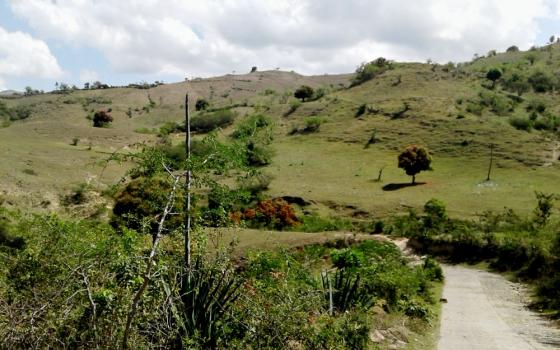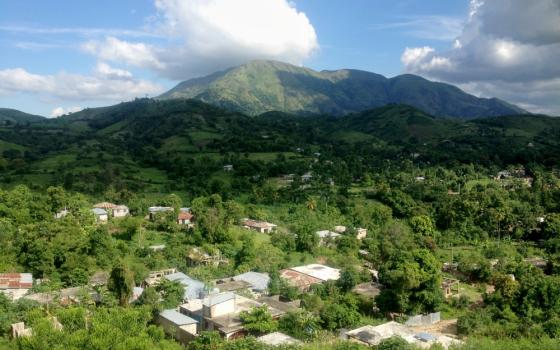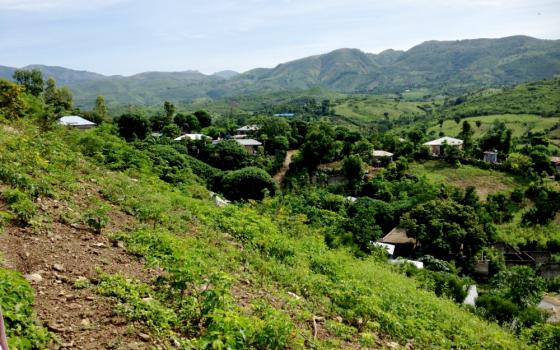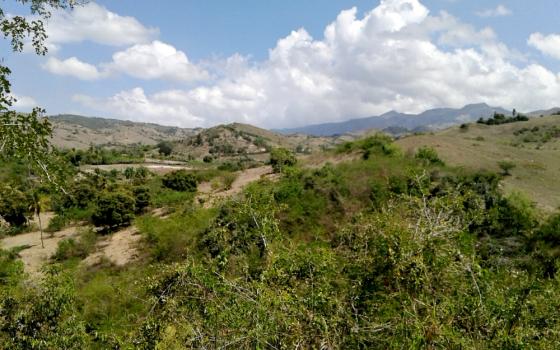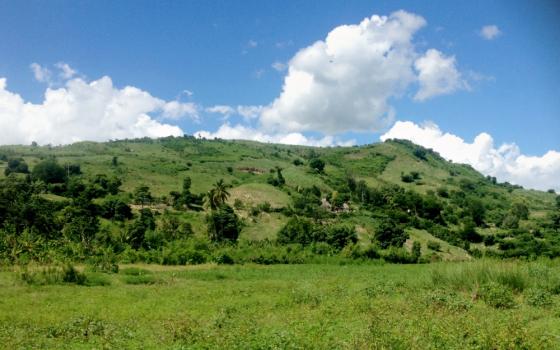Notes from the Field includes reports from young people volunteering in ministries of Catholic sisters. A partnership with Catholic Volunteer Network, the project began in the summer of 2015. This is our seventh round of bloggers: Viviana Garcia-Blanco is a Dominican Volunteer at the United Nations and Geri Lanham is a volunteer with the Religious of Jesus and Mary in Gros Morne, Haiti.
___
Haiti is only the size of Maryland, but traveling in this island nation warps my sense of time and distance.
Haitian President Jovenel Moïse has begun roadwork from Gonaïves, the capital of our department, where the national highway changes from asphalt to dirt, but no one is celebrating yet. Even as the roadwork crew smooths the road with huge tractors and lays the first layers of asphalt, people hold their praise until they see if this project will be finished in a manner that will greatly impact their ability to travel and, hence, improve their quality of life.
When I was growing up, my family would often traverse the 120 miles from our house to my grandparents' house without thinking anything of this two-hour journey on a smooth asphalt road. But here, the prospect of a 120-mile journey means multiple modes of transportation and an entire day of travel.
This morning, I hopped on the back of a fire-engine-red motorcycle taxi with one of my preferred drivers to head north farther into the countryside of Haiti. Compared to our destination of the communal section of Pendus, Gros Morne is a mecca that boasts egg sandwich restaurants and sidewalk bars with refrigerators, powered by the occasional electricity from the national grid and backup batteries that hold a good charge.
As we made our way north, my driver, Obenson Gelus, and I carried on a lively exchange of the news of the week, which caused some people walking along the dirt road to call out, "Oh, driver, you speak English?" None of them could imagine that I might speak Creole.
The sight of a white woman on the back of a motorcycle is not common here in the countryside. But I enjoy this mode of transportation. People along the route are friendly, calling out greetings to us as we pass by their roadside stands of firewood, candies and fruit. We see many children on their way to school, each group in a different-colored uniform to distinguish where they go to school. Obenson is a great driver, and the motorcycle can find the smoothest path between the rocks on the mountain roads that a car could not pass.
After an hour of mostly smooth riding, we turn off the national highway onto a secondary road, which feels more like a roller coaster because of the deep ruts and holes Obenson skillfully avoids as we make forward progress. We come to a point that feels like it might be the edge of the world, as we look straight at the horizon and see mountain peaks, and the ground seems to drop from below the wheels of the moto.
My stomach flip-flops as we start to nosedive into the valley. I hold on tighter, and Obenson laughs a little that I have not yet gotten used to this feeling of free fall on the mountain roads. I am a flatlander from Illinois, and I do not think this will ever feel normal to me.
At the bottom of this ridiculously steep hill, I hop off the motorcycle to walk very gingerly across the river in this valley, then continue to walk up the other side of the mountain since the motorcycle would struggle to carry both Obenson and me up the mountain. I find Obenson waiting for me at the top, and we spend a few minutes admiring the view.
While this zone is fairly green, with grass and bushes on the mountainsides, we do not see many gardens. This is the beginning of the spring planting season, but when we ask some locals walking down a mountain path, we learn that rain has not yet fallen in any great quantity in this area. If the rains do not come, people cannot begin to plant with any hope of success. The river that I crossed in the valley did not pass my ankles today, so people could not even find enough water to carry on their donkeys to water mountainside gardens if the rain does not fall.
We all hope the rains fall soon, because otherwise, it will be a hungry season for the families of this zone.
Although I know this zone is fairly populated, we do not see many houses near the road. But when we look higher up into the mountains, we see paths that look impossibly steep that have houses scattered along them. I cannot imagine carrying sacks of provisions or buckets of water up to a household like this. But people do this task daily.
This zone is rural, but when I talk to people, I find that they are amazingly mobile, connected to the larger cities in Haiti and to countries across the ocean. This transnationalism is common in Haitian families, who work very hard to send someone lòt bò, which literally means "over there," across the ocean to find work that can help to support the family who stays back home in Haiti. Most people here in Pendus have family in Port-au-Prince or Cap-Haïtien, the second-largest city of Haiti, as well as somewhere across the ocean.
Young people in this area talk about their dreams to travel not just to Gros Morne or to Port-au-Prince, but across the ocean, too, in order to find a better life for themselves. The countryside where they live does not offer many opportunities for them, especially when the rain does not permit their families to plant a subsistence garden.
But the rural community, while they depend upon support from other places, must also have some way to engage their youth, because without young people, these rural communities cannot hope to survive. They may not be a place where people think to travel, but they must be a place that can give those who live there a solid foundation from which to flourish.
[Geri Lanham lives in community with the Religious of Jesus and Mary in Gros Morne, Haiti.]
